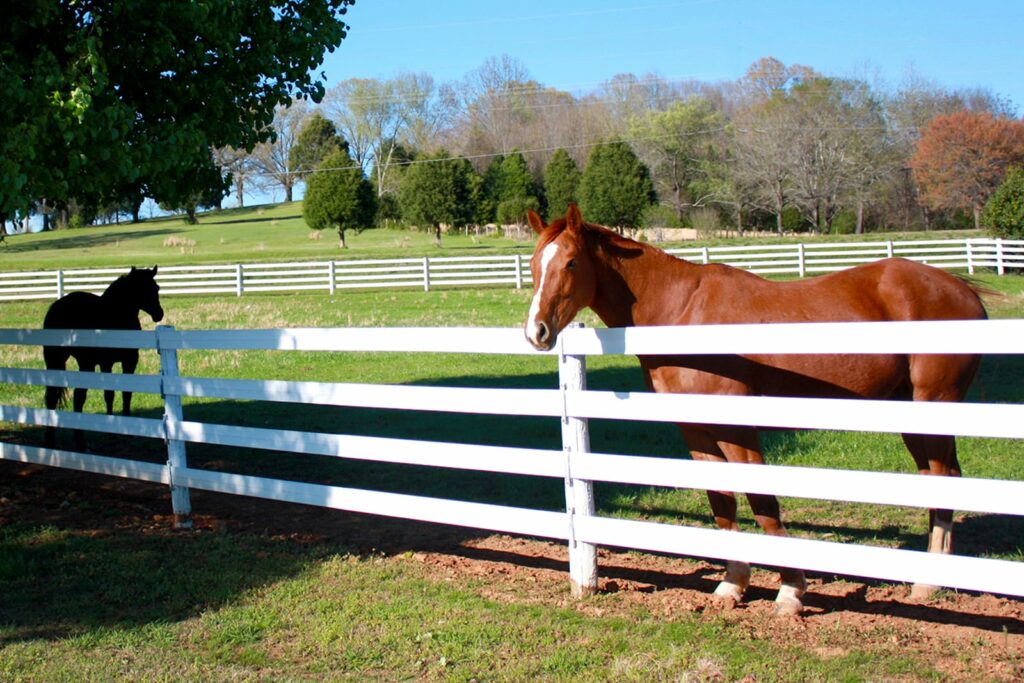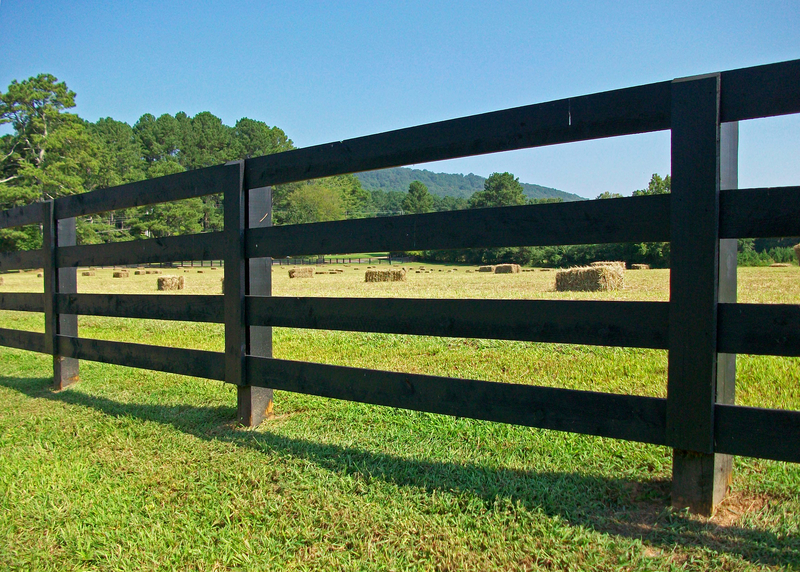Stock & Noble
Types of Post and Rail Fencing Available in Australia.
- BY Tripti Kakkar
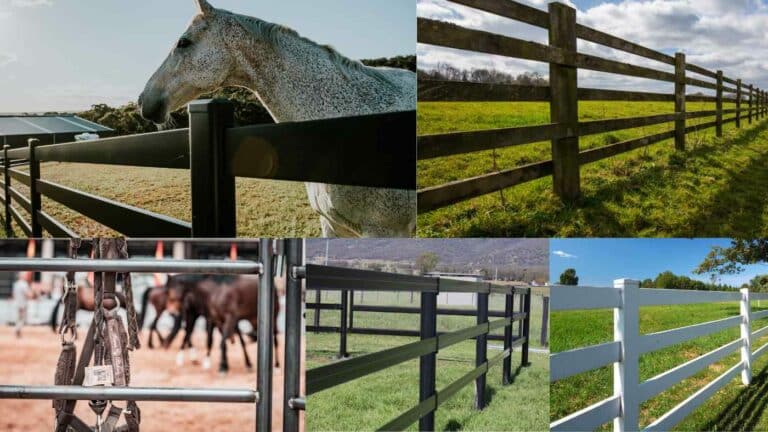
Whether you are building your dream property or want some new fencing for your existing one? You are at the right place. While there are a plethora of fencing solutions available in our country, the fencing conversation starts with Post and Rail fencing and sometimes ends here too. Post and rail fences are widely used for various purposes, including property boundaries, livestock containment, and aesthetic appeal.
It’s the most popular, most loved, most durable and sometimes the costliest fencing out there. If you’re searching for detailed information on different types of post and rail fencing, congratulations, this article is all that you’ll need.
At Stock and Noble, we provide high-end property owners across Australia and New Zealand with the finest fencing solutions. While Premium Steel Post and Rail Fencing, Horserail and Legacy Rail belong to our fencing portfolio, we also have in-depth knowledge and expertise in the entire post and rail fence category. Based on insights gained from live client projects and interaction with experts on the ground, we will share a comprehensive guide on the types of post and rail fencing.
In this article, we will delve into the key aspects of each post and rail fencing, including:
- Timber Post and Rail Fencing
- PVC Post and Rail Fencing
- Steel Post and Rail Fencing
- Cattle Rail Fencing
- Flexible Rail Fencing
Post and Rail Fencing Type 1: Timber Post and Rail Fencing

Image of Hardwood Timber Post and Rail Fencing
Timber post and rail fencing is a popular choice for many applications due to its rustic charm and durability. There are two types of timber fencing majorly used across rural and acreage properties: Treated Pine and Hardwood.
However, like any other fencing option, it has its own set of pros and cons.
Pros of Timber Post and Rail Fencing
1. Timber Post and Rail Fencing has a Natural aesthetic appeal
Timber post and rail fencing has a natural and rustic look that complements various landscapes, especially rural and countryside settings. It adds a touch of warmth and character to the surroundings.
2. Timber Post and Rail Fencing is Versatile
This type of fencing can be customised to suit different needs and preferences. It can be installed at different heights and lengths, allowing for a flexible design that can accommodate various areas and purposes.
3. Timber Post and Rail Fencing is Durable
Timber, when properly treated and maintained, can be highly durable. Good quality timber fencing can withstand the elements, including sun, rain, wind, and even pests, for an extended period.
4. Timber Post and Rail Fencing is Cost-effective
Compared to some other fencing materials, treated pine post and rail fencing can be cost-effective option. The installation and maintenance costs can be relatively low compared to more complex fencing systems. You may want to check the availability and supply timeframes.
5. Timber Post and Rail Fencing is Easy to install
Timber post and rail fencing can be relatively easy to install, especially if you have basic DIY skills. The posts can be driven into the ground, and the rails can be attached to them with screws or nails. This simplicity can save time and effort during the installation process. Most fencing contractors are familiar with this product.
Cons of Timber Post and Rail Fencing
1. Timber Post and Rail Fencing is Tough to Maintain
Timber fencing requires regular maintenance to ensure its longevity. It needs to be stained, painted, or sealed periodically to protect it from weathering, rot, and insect damage. Without proper maintenance, the timber can deteriorate over time.
2. Timber Post and Rail Fencing is Susceptible to rot and pests
Timber is a natural material and can be susceptible to rot, especially if it is not adequately protected. Additionally, insects and pests, such as termites, can infest and damage timber fencing if proper precautions are not taken. If your property is in a termite-prone area, it will be worth learning how to manage termites on your property.
3. Timber Post and Rail Fencing is not Safe
It is a known fact that horses love to chew on timber fencing.
if you have a windsucker horse then your post and rail might be chewed on pretty intensely. It could pose a huge health risk. Also, if timber isn’t strong enough and a horse runs into it with force he might get impaled on the broken shards or post. Dig deeper if you’re specifically looking for some anti-cribbing solutions and find out if there’s an answer to horse cribbing.
4. Timber Post and Rail Fencing has a Shorter Lifespan
Despite being durable, treated pine fencing may have a shorter lifespan compared to other materials like flexible rail or steel post and rail. The exact lifespan can vary depending on the quality of the timber, maintenance practices, and environmental factors.
5. Timber Post and Rail Fencing has a considerable Environmental Impact
The use of timber in fencing raises concerns regarding deforestation and sustainability. It is important to ensure that the timber used is sourced from responsibly managed forests or opt for reclaimed or recycled timber to minimize the environmental impact.
There are other hidden problems with timber post and rail fencing that can occur post-installation and you should be aware of them.
It’s worth noting that the pros and cons can vary depending on the specific type of timber used, the quality of craftsmanship, and local environmental conditions. Consulting with a professional installer or researching specific timber options can help in making an informed decision.
Post and Rail Fencing Type 2: PVC Post and Rail Fencing
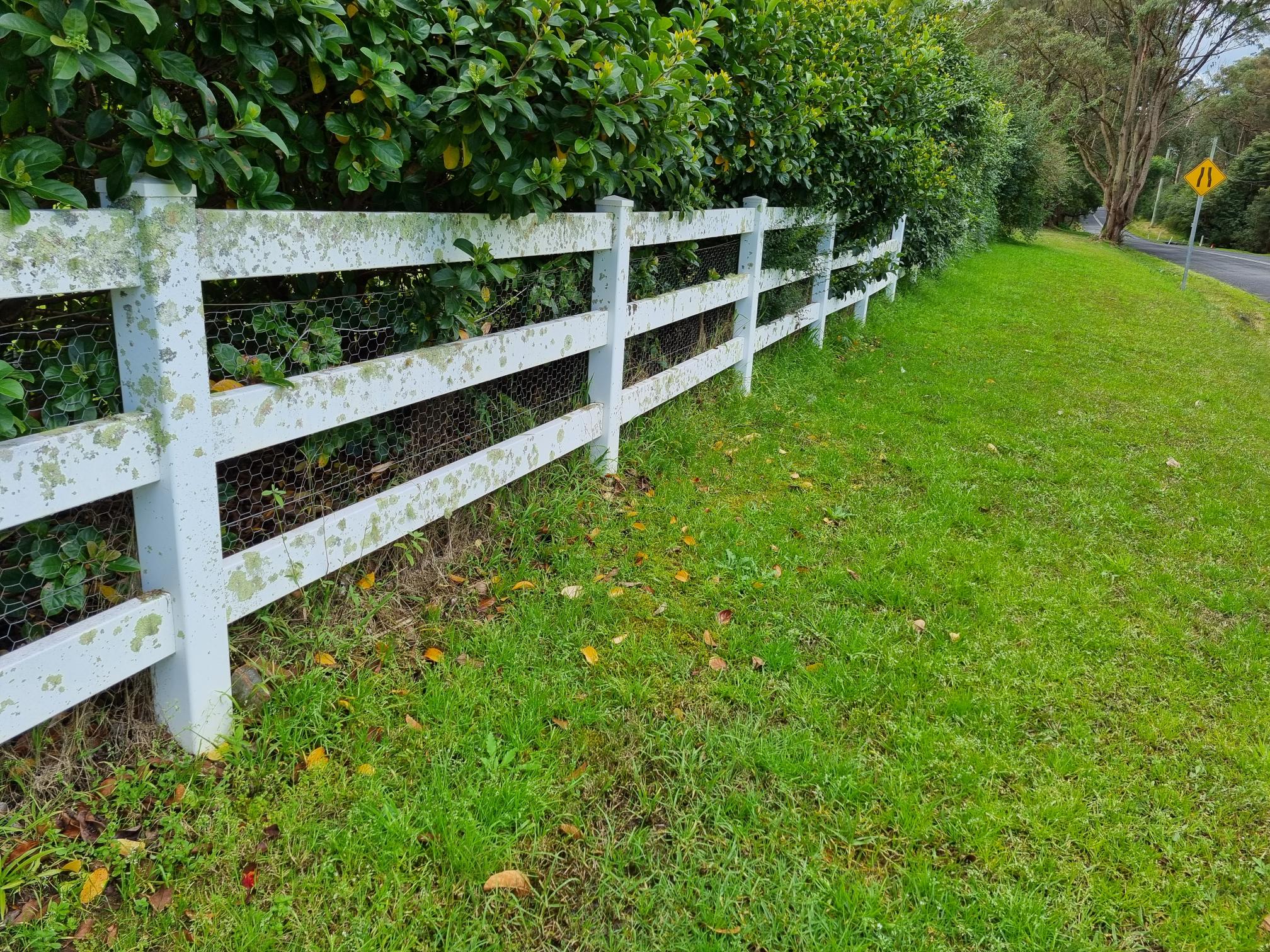
Image of PVC Post and Rail Fencing
PVC post and rail is a type of fencing system that utilizes PVC (Polyvinyl Chloride) as the primary material. PVC is a synthetic plastic polymer known for its strength, durability, and resistance to weathering, rot, and pests. It is commonly used in construction and fencing applications due to its longevity and low maintenance requirements.
PVC post and rail fencing typically consists of horizontal rails supported by vertical posts. The rails are attached to the posts, creating a sturdy and visually appealing fence. The number of rails can vary depending on the desired height and style of the fence.
PVC (polyvinyl chloride) post and rail fencing is another popular option that offers a range of benefits and drawbacks. Here are some pros and cons of PVC post and rail fencing:
Pros of PVC Post and Rail Fencing
1. PVC Post and Rail Fencing is Easy to Maintain
One of the main advantages of PVC post and rail fencing is its low maintenance requirements. Unlike timber, PVC does not require staining, painting, or sealing. It is resistant to rot, insects, and weathering, making it a durable and long-lasting option.
2. PVC Post and Rail Fencing is Easy to Clean
PVC fencing can be easily cleaned with soap and water, removing any dirt or stains that may accumulate over time. This simplicity of maintenance can save time and effort in the long run.
3. PVC Post and Rail Fencing Offers a Variety of Styles and Colours
PVC post and rail fencing is available in various styles and colours, allowing for customisation to match different aesthetic preferences. It can mimic the look of traditional timber fencing or offer a more modern and sleek appearance.
4. PVC Post and Rail Fencing is durable
PVC is a strong and resilient material that can withstand harsh weather conditions, including UV rays, moisture, and temperature fluctuations. It does not warp, rot, or splinter over time, making it a reliable choice for outdoor applications but may not be strong enough to contain horses.
5. PVC Post and Rail Fencing is Safe
PVC fencing typically has smooth surfaces without any sharp edges or nails, which can be safer, especially for horses. The absence of splinters or protruding parts reduces the risk of injury.
Cons of PVC Post and Rail Fencing
1. PVC Post and Rail Fencing has a Higher Initial Cost
PVC posts and rail fencing tend to have a higher upfront cost compared to timber fencing. The manufacturing process and the quality of the materials contribute to the higher price tag. However, it’s important to consider the long-term savings in maintenance and replacement costs.
2. PVC Post and Rail Fencing has Limited flexibility
Unlike timber, PVC fencing is not as flexible or malleable. This can cause the rails to shatter under impact and run the risk of your horses being injured by the sharp shards.
3. PVC Post and Rail Fencing has Environmental Concerns
PVC is a synthetic material derived from petroleum. Its production and disposal can have environmental impacts, including the release of toxic chemicals. However, some manufacturers now offer PVC fencing made from recycled or sustainable materials, which can mitigate these concerns to some extent.
4. PVC Post and Rail Fencing has a Potential for Fading
Over time, PVC fencing may experience some degree of fading or discolouration due to exposure to sunlight. While high-quality PVC fencing is designed to resist fading, prolonged UV exposure can cause some colour changes.
5. PVC Post and Rail Fencing Expands and Contracts in Heat
PVC has a higher coefficient of expansion and contraction compared to materials like timber. In extreme temperature conditions, it can expand or contract, which may affect the structural integrity of the fencing. Proper installation techniques, including appropriate spacing and allowances, can help minimize this issue.
6. PVC Post and Rail Fencing is Susceptible to Mould
Vinyl fences often face the challenge of mould growth, which is primarily caused by water retention and the presence of dust or nearby trees. Among these factors, water retention plays a significant role and can be attributed to various elements such as sprinklers, rainfall, snow, or morning dew. When water droplets accumulate within the cracks and crevices of the vinyl material, it creates an ideal environment for mould bacteria to flourish. The fence posts and baseboards are particularly vulnerable areas where water can collect and persist, making them highly prone to mould growth. To prevent this issue, regular cleaning and maintenance are essential to ensure that your PVC fence remains mould-free.
Considering these pros and cons can help you make an informed decision about whether PVC post and rail fencing is the right choice for your specific needs and preferences.
Post and Rail Fencing Type 3: Steel Post and Rail Fencing
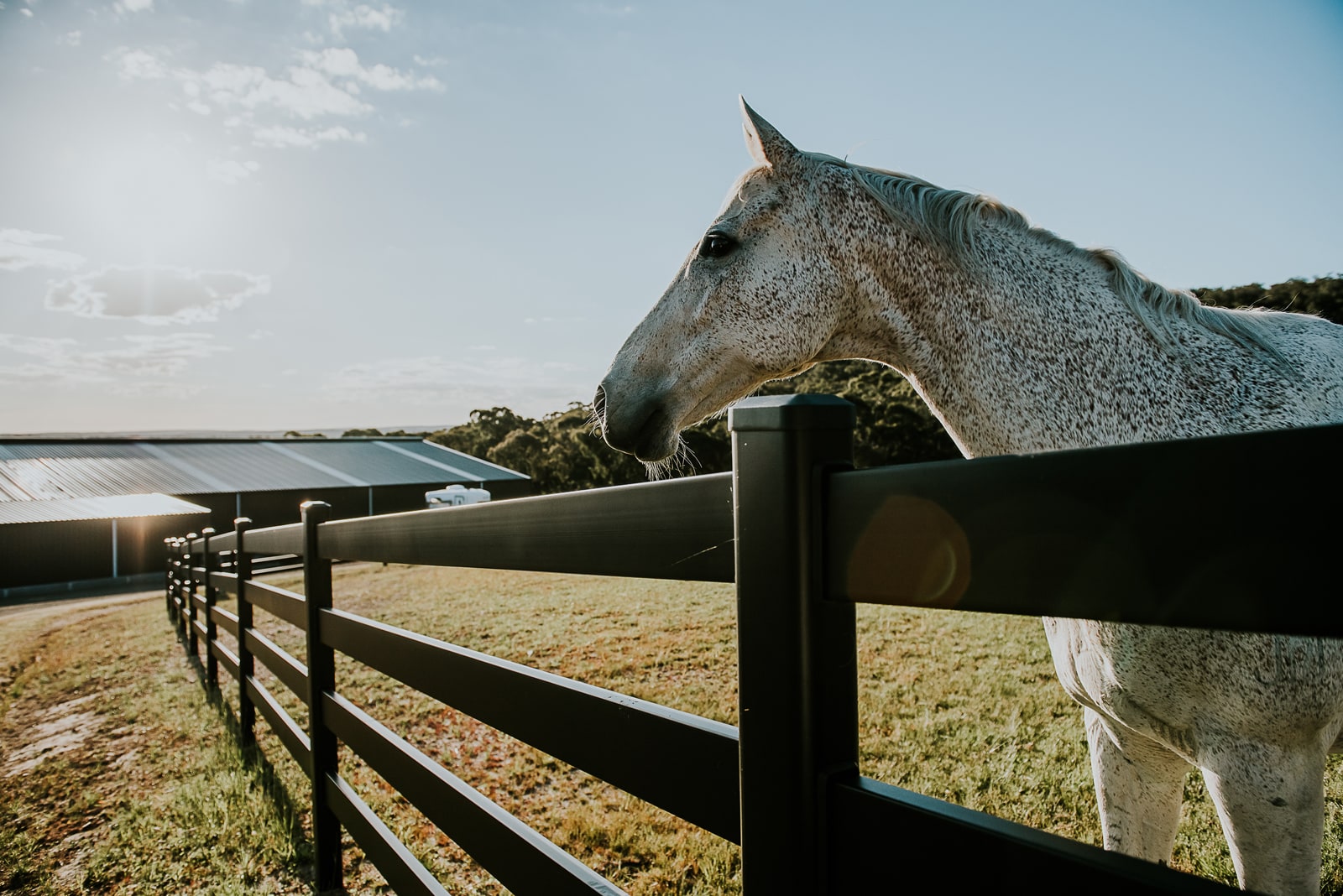
Image of Premium Steel Post and Rail Fencing
Steel post and rail fencing is a durable and sturdy option for various applications. In this article, we will focus on the specifications of Premium Steel Post and Rail fencing or Buckley.
Buckley is the only engineered steel post and rail fencing system in the world. It is safe for animals as well as environmentally friendly. It is made with 2-sided pre-galvanised steel, treated with a phosphate conversion coating for added protection and finished with an architectural grade polyester powder coat.
A complete review of Buckley Steel Post and Rail Fencing could further prove helpful in your research for the finest fencing.
Here are some pros and cons of steel post and rail fencing:
Pros of Steel Post and Rail Fencing
1. Steel Post and Rail Fencing is Strong and Durable
Steel is a strong and durable material that can withstand harsh weather conditions, impact, and pressure. It is highly resistant to rot, warping, and insect damage, making it a long-lasting fencing option.
2. Steel Post and Rail Fencing is Safe for Animals
Premium steel fencing system is an engineered system that will withstand day-to-day bumps and kicks but will buckle on direct running impact.
It has rounded smooth edges with no nails or screws reducing the risk of cuts to animals’ delicate skin. The rails are designed to flex on impact preventing serious harm.
3. Steel Post and Rail Fencing is Easy to Maintain
Premium Steel fencing requires little to no maintenance. It does not require staining or painting like timber.
4. Steel Post and Rail Fencing is Aesthetically Impressive
Premium steel post and rail has a visually appealing design that can significantly enhance the overall appearance of your property and add value.
5. Steel Post and Rail Fencing is Fire Resistant
Steel is non-combustible and has a high fire resistance compared to materials like timber. This feature can be crucial for areas prone to wildfires or where fire safety is a concern.
Cons of Steel Post and Rail Fencing
1. Steel Post and Rail Fencing Costs Higher
Steel post and rail fencing is more expensive compared to other materials like timber or PVC. The cost of steel can be higher, especially for larger fencing projects. However, the durability and longevity of steel can offset these initial expenses and ends up costing less over the length of time it will last.
Here are some of the reasons how Premium Steel Post and Rail Fencing gives high return on investment.
2. Steel Post and Rail Fencing has a Potential for Rust
While premium steel is resistant to rust and corrosion, it is not completely immune. If the coating or paint on the steel fencing gets damaged or wears off, the steel can be susceptible to rust, especially in areas with high humidity or exposure to saltwater. Regular maintenance and inspections are necessary to prevent rust formation. Premium steel fence system has a 15-year warranty on its paint coating.
It’ll be worth learning about the performance of different types of steel post and rail fencing against rust.
3. Steel Post and Rail Fencing is Difficult to Install on a slope
Installing steel post and rail fencing on a slope can be more challenging compared to other fencing materials. If your gradient is more than 22 degrees, then this system won’t work for your property
4. Steel Post and Rail Fencing has a Limited Colour choice
It is only available in 2 colours. If you are looking for a custom tone unfortunately that is not available with this high-end solution.
5. Steel Post and Rail Fencing Cannot be Customised
It comes in standard sizes and options. Within the system, you cannot customise your post sizes or upgrade to larger fence posts. Steel post and rail fencing may not have the same natural or rustic aesthetic appeal as timber.
Considering these pros and cons can help you evaluate whether steel post and rail fencing is the right choice for your specific needs, budget, and preferences. It’s also advisable to consult with professionals or experts in fencing to determine the most suitable option for your particular circumstances.
Post and Rail Fencing Type 4: Flexible Plastic Rail Fencing
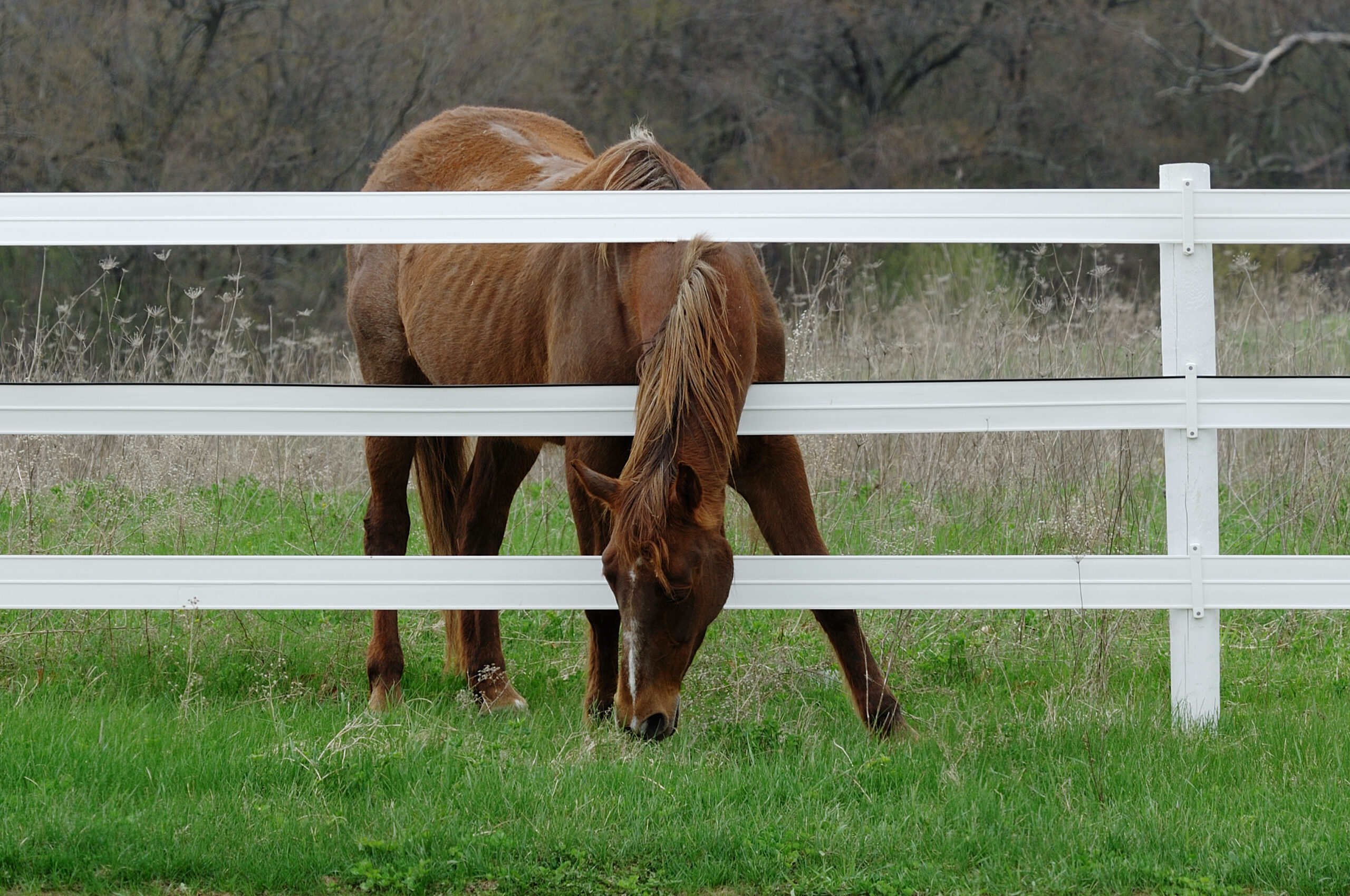
Image of Flexible Rail Fencing
When it comes to Flexible Plastic rails, Horserail is the most sought-after and widely recognized brand. This top-tier horse fencing is proudly manufactured in America and utilizes premium-grade Medium Density Polyethylene (MDPE). The MDPE is specially formulated with a UV stabilisation package, ensuring superior durability and longevity, even in harsh weather conditions.
With its exceptional quality and performance, Horserail has become synonymous with the entire category of flexible plastic horse fences. It is essential to be cautious when purchasing the original Horserail, as there are imitations in the market.
Flexible plastic post and rail fencing, often made from materials like medium-density polyethylene (MDPE), offers unique advantages and disadvantages.
Pros of Flexible Plastic Rail Fencing
1. Flexible Rail Fencing is High on the Safety
Flexible plastic rail fencing is designed with rounded edges and smooth surfaces, making it safe for both humans and animals. There are no sharp edges or splinters that could cause injury, making it an excellent choice for areas where safety is a concern, such as paddocks or equestrian enclosures.
2. Flexible Plastic Rail Fencing is Durable
Plastic fencing materials, particularly MDPE, are known for their durability and resistance to rot, decay, and weathering. They are not susceptible to rust, corrosion, or insect damage, making them ideal for outdoor applications. Plastic fencing can maintain its structural integrity even in harsh environments.
3. Flexible Rail Fencing Needs Low Maintenance
Horserail requires minimal maintenance. They do not need painting, staining, or sealing. Cleaning the fence with water and mild detergent is usually sufficient to remove dirt and debris. Plastic does not fade or discolour significantly over time, reducing the need for regular maintenance tasks.
4. Flexible Rail Fencing is Environmentally friendly
Horserail is made from recycled materials, contributing to environmental sustainability. Additionally, plastic does not leach chemicals into the soil, making it a safe option for gardens, farmlands, or areas near water bodies.
5. This Post and Rail Fencing is Highly Flexible
Horserail or Legacy rail can absorb impact and flex under pressure without breaking, making it suitable for areas with frequent movement or potential impacts. It can withstand strong winds, animal pressure, and accidental collisions, reducing the risk of fence damage.
Cons of Flexible Plastic Rail Fencing
1. This Post and Rail Fencing has Limitations on Visual Aesthetics
While plastic rail fencing can be manufactured in various colours, it may not have the same natural or rustic appearance as timber or the versatility of other materials. Some people may find plastic looks less appealing, especially in more traditional or countryside settings.
2. Flexible Rail Costs Higher Initially
The upfront cost of flexible plastic fencing can be higher compared to traditional timber options. The manufacturing processes and materials involved contribute to the higher price tag. However, it’s important to consider the long-term savings in maintenance and replacement costs.
3. This Post and Rail Fencing offers Limited customisation
Plastic fencing typically comes in standard designs and sizes, limiting customization options. Unlike timber or other materials, it may be more challenging to modify or adjust plastic fences to fit specific yard sizes or gradients.
4. Electrics is a concern with Flexible Rail
Horsrail and other plastic rails have electric wires encased in the plastic. So, if you have a problem with the electrics it can be more difficult to find compared to a separate electric rope run on top of a timber post or rail. Legacy Rail is a non-electric rail option
5. Environmental impact of Flexible Rail
While some plastic post and rail fencing options use recycled materials, plastic production and disposal still raise concerns about environmental sustainability. Plastic is derived from non-renewable resources and can take a long time to decompose. Choosing recycled or environmentally friendly plastic options can help mitigate these concerns to some extent.
Post and Rail Fencing Type 5: Cattle Rail

Image of Steel Pipe Post and Rail Fencing
Cattle Rail is also called Steel Pipe or Tubular fence and as the name suggests it looks like a pipe or a tube. Also known as ranch or farm fencing, is specifically designed to contain livestock such as cattle, horses, or other large animals.
Steel Pipe is only a pre-galvanised steel fence with no painting or powder coating on top.
Renowned for its ability to withstand the test of time, Cattle Rail is a preferred choice for those in need of a sturdy and reliable option. Not only is it easy to maintain, but it also offers long-term cost-effectiveness compared to other post and rail alternatives. Before the introduction of premium steel post and rail fencing solutions like Buckley to Australia and New Zealand, Cattle Rail stood as the sole option for steel fencing, leading to its widespread use in high-end properties throughout the country.
Learn more about the key differences between Cattle Rail and Premium Steel Post and Rail Fencing.
Here are some pros and cons of Cattle Rail.
Pros of Cattle Rail
1. Cattle Rail is Strong and Durable
Cattle rail post and rail fencing is constructed using robust materials, such as heavy-duty steel, which provide strength and durability. This type of fencing is designed to withstand the force of large animals, ensuring they remain contained within the designated area.
2.Cattle Rail is Effective in Animal containment
The primary purpose of cattle rail post and rail fencing is to contain livestock effectively. The sturdy construction and height of the fence act as a physical barrier, preventing animals from straying or accessing restricted areas.
3. Cattle Rail offers Security
Cattle rail fencing enhances the security of livestock by keeping them protected from potential predators or unauthorised individuals. The strong and visible fencing acts as a deterrent, reducing the risk of animal theft or harm.
4. Cattle Rail Lasts a Long Time
Depending on the maintenance, cattle rail post and rail fencing can have a long lifespan. Steel fencing, when properly maintained, can last for many years without significant deterioration. Treated wood options can also provide durability and longevity, especially when protected from moisture and rot.
5. Cattle Rail is Customisable
Cattle rail can be customised to meet specific equine requirements. It can be adjusted in terms of height, spacing between rails, and overall design to accommodate different horses’ needs or landscape gradients.
Cons of Cattle Rail
1. Cattle Rail can be Complicated to Install
Cattle rail often requires professional installation due to its size, weight, and complexity. Erecting the posts and ensuring proper welding of rails can be challenging for those without the necessary expertise or equipment.
2. Cattle Rail might Cost Higher
Cattle rail can be more expensive compared to other fencing options, especially when using materials like heavy-duty steel. The initial investment in materials and installation may be higher, although the long-term benefits and durability can offset these costs.
3. Cattle Rail has Specific Maintenance Requirements
Cattle rail requires regular painting and welding of rails for maintenance. Wood fencing, for example, needs periodic staining or painting to protect against rot and decay. Steel fencing may require inspection for rust and reapplication of protective coatings. Premium steel post and rail has an architectural grade coat and therefore there is no need for regular maintenance.
Learn more about the performance of different steel post and rail fencing against rust.
4. Cattle Rail isn’t Safe for Horses
The solid construction of cattle rail is designed for cattle and it’s not ideal for horses. It has no give or flexibility and can cause injuries to horses
5. Cattle Rail might not be High on Aesthetics
Cattle rail post and rail fencing may not provide the same aesthetic appeal as other fencing options, particularly for high-end properties The focus of this type of fencing is functionality and durability, which may not align with certain aesthetic preferences.
When considering Cattle rail, it’s essential to assess the specific requirements of your horses and property.
Which Post and Rail fencing is Best for my Property?
Post and rail fencing is a popular choice for property owners in Australia and New Zealand due to its versatility, aesthetic appeal, and functionality. You wanted to deep dive into the world of post and rail fencing and know the variety available in the market.
This article provided a comprehensive guide to different types of post and rail fencing, including timber, PVC, steel, and flexible plastic rail fencing.
- Timber post and rail fencing offers a natural and rustic look, versatility in design, and cost-effectiveness. However, it requires regular maintenance, is susceptible to rot and pests, and raises environmental concerns.
- PVC post and rail fencing is known for its low maintenance requirements, durability, and variety of styles and colours. It is easy to clean and offers safety benefits, but it has a higher initial cost, limited flexibility, and potential for fading.
- Steel post and rail fencing is a durable option with strength, safety features, and low maintenance. It is aesthetically impressive and has high fire resistance. However, it is more expensive, and may be difficult to install on slopes.
- Flexible plastic rail fencing, such as Horserail, provides safety, durability, low maintenance, and environmental friendliness. It is flexible and can absorb impact, but it may lack the natural aesthetics of timber and customization options. Additionally, the upfront cost can be higher.
Cattle Rail is a strong and functional fencing for cattles, but it has a potential to rust and isn’t considered safe for horses.
Each type of post and rail fencing has its own advantages and disadvantages, and the choice depends on individual needs, preferences, budget, and environmental considerations. The next step would be to know the cost of different post and rail fencing solutions so you can make an informed decision.
If you have more questions on the suitability, availability, warranty or installation of post and rail fencing solutions consulting with our fencing expert would surely prove useful. So, book a personalised consultation to get all your questions answered and gain in-depth knowledge to help you create a safe and beautiful property.

